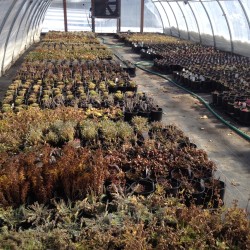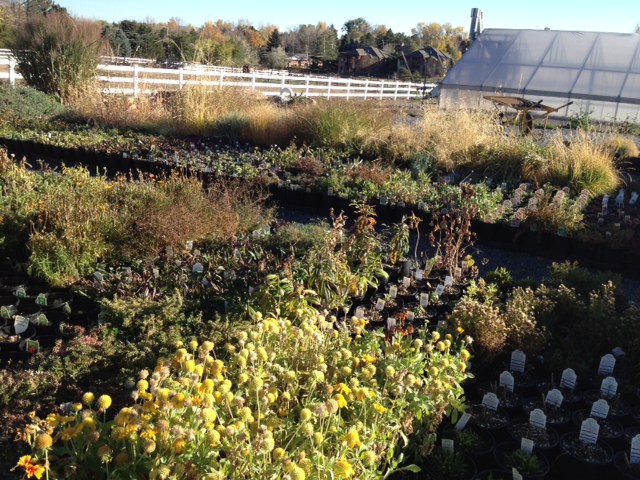Preparing our gardens for the winter is important. Most of the greenhouses at Creek Side have been ‘winterized’ for the season. A few of the houses have potted plants in them whether it is heated or not. Our perennials are tucked away in the ‘cold’ house. This greenhouse offers protection to the plants from the wind and very severe cold winter temperatures. Once these plants are dormant and used to the cold temperatures, they do not like the warm temperatures that will occur on sunny days. We will ventilate the houses during the day so that it does not get too  warm. The perennials being over-wintered at Creek Side were planted this past summer for sale next spring.
warm. The perennials being over-wintered at Creek Side were planted this past summer for sale next spring.
At the Greenhouse
House 1, located behind the glasshouse is warm and cozy for growing our spikes and cordylines. As these are slow growers, they need time to mature to be ready as a ‘thriller’ for our container gardens in the spring. The other heated house is our glasshouse conservatory attached to the store. We carry houseplants year-round for all you indoor gardeners. Thanksgiving week we will receive our Poinsettias, Christmas Cactus and other holiday flowering plants. The glasshouse comes alive with flowers and color, just what someone may need on a cold winter day. To make room for  all the holiday plants, we then transfer our houseplant to House 1 which is close by for houseplant shoppers.
all the holiday plants, we then transfer our houseplant to House 1 which is close by for houseplant shoppers.
At your Home
We like to refer to it as ‘putting your garden to bed.’ Just as we put away our plant material in the cold frames or cold houses. There are two schools of thought for preparing your perennial bed for winter. Some folks like the landscape to be all neat and tidy for the winter season. So you may cut back any flowers, foliage and stems from perennials down to about 6-8″. Other gardeners are interested in providing habitat for beneficial insects to over winter. In which case, leave short perennial stems alone and cut tall perennial stems in half. Adding extra mulch around the base of shrubs, trees and roses is helpful for retaining moisture and insulation. Clean out most debris such as tree leaves, so if you need to water and/or it snows, the moisture can penetrate the soil down to the roots.
Install rose collars around your roses and fill with mulch or leaf rakings to protect the graft over the winter. Wrap youg trees trunks with tree wrap to protect from the sun during the winter months.
Winter Watering is Important
The result of long, dry periods during fall and winter is injury or death to parts of plant root systems. Affected plants may appear perfectly normal and resume growth in the spring using stored food energy. But some plants may be weakened and all or parts may die in late spring or summer when temperatures rise.
Exposed sites are more subject to winter freezing and thawing. Our persistent freeze/thaw process opens cracks in soil that expose roots to cold and drying. Also, weakened plants (due to lack of winter watering) may be subject to insect and disease problems.
Winter Water Guidelines
If we have had no measurable moisture for 3-4 weeks, it is important to water your plant material, especially newly planted perennials, trees, shrubs and roses. Here are a few basic guidelines you can follow.
- Water only when air temperatures are above 40 degrees F.
- Apply water at mid-day so it will have time to soak in before possible freezing at night.
- Water from the hose or attach a sprinkler for broadcasting water. You can also attach a deep root water needle.
- For trees, disperse water sites evenly within the circle bounded by the dripline. The dripline refers to the extended branches and straight down from there is your ‘dripline’.
- Trees – As a general survival rule, apply 10 gallons of water for each diameter inch of the tree. For example, a two-inch diameter tree needs 20 gallons per watering.
- Shrubs and roses – Apply 5 gallons two times per month for a newly planted shrub. Small established shrubs (less than 3 feet tall) should receive 5 gallons monthly. Large established shrubs (more than 6 feet) require 18 gallons on a monthly basis.
- Perennial beds – use a sprinkler and generously water each section for about 30 minutes.
- REMEMBER to disconnect your hose from the house after use as not to freeze your water line.

